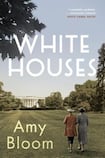
Although it was something of an open secret in the White House during the Franklin Roosevelt years, the first lady's long-standing love affair with reporter Lorena Hickok has been the subject of much (predictable) controversy. Set during the Great Depression, when "stockbrokers were jumping out of windows and farmers were killing their families and hanging themselves from oak trees", Amy Bloom's vivid reimagining of the relationship between the Eleanor Roosevelt and Lorena Hickok subtly draws out the class differences between the two, interweaving their contrasting histories with the cultural tensions of pre-war America. Based on much research, Bloom's historical fiction is neither gossipy nor incendiary: in fact, White Houses is a tender, heart-warming exploration of a hidden but profound love.
In the 1980s, Eleanor Roosevelt's biographer Doris Faber published a selection of the nearly 3,000 letters between the First Lady and 'Hick' held in the archives at Hyde Park, but the close and clearly romantic relationship between the two women was dismissed as friendship. Later, historians such as Blanche Weisen Cook (whom Bloom credits as an inspiration) began to raise questions, revealing earlier dismissals of the relationship as homophobic and prudish. In 2016, there was renewed interest when Eleanor and Hick's relationship became the subject of a non-fiction work by Susan Quinn. What Amy Bloom's latest novel, White Houses, achieves is both a skilful inhabitation of the historical record and a generous, passionate gifting of humanity and warmth back to the couple.
‘First Friend’
Beginning with Eleanor and Hick's "golden time", when Hick was moved into the White House alongside the president and first lady, swiftly dubbing herself "First Friend" after being cropped out of numberless press photographs, Bloom's narrative takes us back into Hick's childhood, relating the devastating abuse she suffered at the hand of her father, her stint as a maid, and eventually her promotion into the White House. What is most impressive about White Houses is the way that Bloom has managed to reach into these real-life figures and to make them into characters; how she can, with admirable economy, pinpoint the differences in their personalities.
Telling the story through the prism of Hick is a useful tool here. As a reporter, an astute observer, Hick narrates White Houses with pithy and often heartrending detail. Although Eleanor is often guarded or aloof, this is partly what Hick admires, and is given in contrast to Franklin's suavity and political sheen: "Franklin said, 'Love me, without criticism or condition', and Eleanor said, 'Be worthy of my love'. Or maybe Eleanor said, 'Make life matter', and Franklin said, 'Make life easy'."
A love story
White Houses is, regardless of the historical figures involved, a love story that is at its most poignant on the communion of souls, on sex and erasure and class and the active repressions of history. If the pace is sometimes slow, this is outweighed by the poignancy of the prose. Hick often allows herself to dream of a life with Eleanor ("We would keep the best of our friends. Our love would create its own world and alter the real one, just a little"), but hits up against the brutal reality curtailing not just her life, but her imaginative freedom. At other times, she relaxes into rapturous meditations.
Bloom’s work is deeply rooted in the archives, but this never feels like a stilted or history-bound book. Instead, it takes the historical moment and opens it up, prising it apart to let in the light. At one moment, early on, Hick tells us about Eleanor: “when I was the object of her love, when her eyes lit up across the room, when she touched her fingertips to the pulse at the base of her throat, to mark the spot for me, to mark herself, I thought that there was no sacrifice I wouldn’t make”. It is a testament to Bloom’s work that these details, even the words themselves, are taken from the letters between the two women, but the result is never impersonal or contrived.
If Eleanor and Hick are often held apart by the weight of social expectation, so we as readers recognise our distance from their lives, but Bloom gives us a way to inhabit them, if only briefly. At one point, later on, Bloom seems to be inviting us to consider this interplay of history, empathy, and separation, with Hick quoting an Emily Dickinson poem to Eleanor: "So we must meet apart – / You there – I – here / With just the Door ajar". With White Houses we are brought to the open door and allowed not just to listen in, but to feel ourselves standing there, living in the moment.











